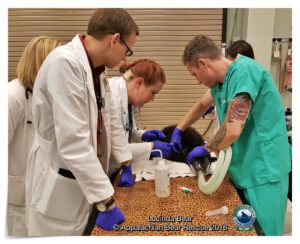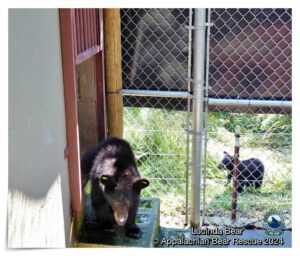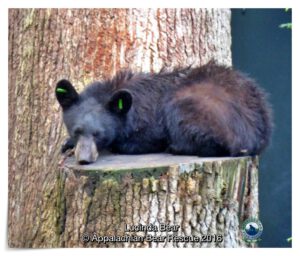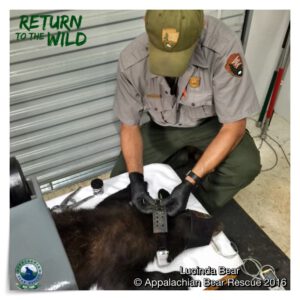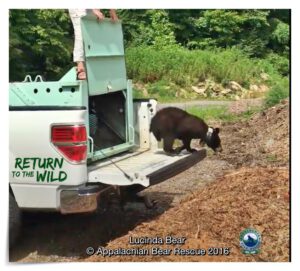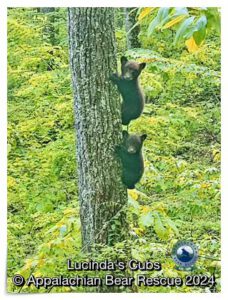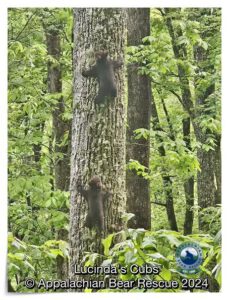ABR got a very happy surprise about a former resident, Lucinda Bear.
Lucinda, a female yearling, arrived at Appalachian Bear Rescue on May 24, 2016. She was about sixteen months old and weighed only 18 pounds, another victim of the Famine of 2015-2016, caused by a failure of the hard mast (acorns and nuts). Bears didn’t hibernate that year because they lacked enough fat reserves to trigger their instinct; instead, they foraged all winter for what little food they could find. It was a terrible year; we took in 36 bears in 2015, followed by another 23 in early 2016. This remains our record, one we don’t want to break.
All Lucinda needed was food and time, and we were happy to provide both. She was a clever cub who outwitted our then-curator, Coy Blair, several times by retrieving cherries from a Hav-a-Hart trap without triggering it. She had only seen a trap once—the day she was rescued—but she seemed to remember how it worked. Curator Coy was reduced to spying on her to see how she did it (it was balance and fancy footwork; very demure, very mindful). Finally, he startled her while she was eating the cherries; she tripped the trap, and the jig was up!
Lucinda spent time in the Cub House and in Acclimation Pen #4, which adjoined Wild Enclosure #4. Unknown to her, she was about to take part in an adventure in babysitting…baby bear sitting, that is. The sole occupant of WE #4 was Finnegan Bear, a cub who’d been in residence for months by himself. With no other cubs around, the curators were willing to take a very calculated risk and release Lucinda with him, hoping they might bond. Yearlings and cubs don’t usually mix in the wild, and that was true at ABR as well. Finnegan was curious about Lucinda, but she wanted nothing to do with him. With the arrival of cubs Andy and Eliza, Lucinda’s services (such as they were) were no longer needed, and she moved to an enclosure of her own.
Lucinda thrived at ABR and was released back into the wild on July 18, 2016, weighing 54 pounds (24.49 kg). Yearlings are returned to the wild as soon as possible; they already have the skills to survive. However, Lucinda didn’t leave as she’d arrived. Unbeknownst to her, she sported a GPS tracking collar as part of Curator Coy’s 2015-2016 GPS collar study of our resident bears, post release. GPS collars are bulky, intrusive, risky, and expensive to operate; this was ABR’s first attempt at a collar study, and something we won’t do again unless their is another study or if a wildlife agency responsible for our bears asks.
Curator Coy followed Lucinda’s wanderings and actually saw a ground den she was using on January 20, 2017, six months after her release. Soon after, her GPS collar disengaged automatically, right on schedule, and Lucinda disappeared into the forest, closing our file on her…until last week.
Wildlife Biologist Ryan Williamson sent us photos of Lucinda (identified by her ear tags), who is now about nine and a half years old. The photos were taken several months ago—and she wasn’t alone! The yearling who wouldn’t babysit for us now has three cubs of her own! To top it off, we learned this is her third known litter. Lucinda established a home range in a remote area, but one visited at least yearly by wildlife biologists who’ve kept tabs on her. There were many leaky eyes at ABR; we’re so happy for Lucinda. This is what second chances are all about, and we thank you for giving Lucinda hers.

As you may have guessed, this description was written by our talented Facebook Administrator, and explained the story so well that there was no point in rewriting it. We do remember this bear, and the terrible famine that year, and are so very glad to hear of the Happy Ending to her story!
Lucinda at rescue.
At her intake exam at UTCVM, she weighed only 18 pounds although she was sixteen months old.
The Acclimation Pen for Enclosure #4. The cub, Finnegan, who didn’t interest Lucinda in the least, is in the background.
In an enclosure of her own,she enjoyed Milo’s Stump.
Lucinda grew and thrived. She was ready for release.
Ranger Ryan Williamson fitted her with a GPS collar, so she could be followed for Curator Coy’s study.
She was released on July 18, 2016, weighing 54 pounds!
Six months later, Curator Coy found a ground den Lucinda had used.
Here is Lucinda Bear 2024, at the age of nine and a half years. She had company with her, too!
Two of her three cubs. The third one stayed hidden.
The cubs are still tiny, as these pictures were taken a few months ago.
They look healthy. We think Lucinda is a good mama bear!
It’s so encouraging to have follow-up like this, especially when it’s such happy news!



